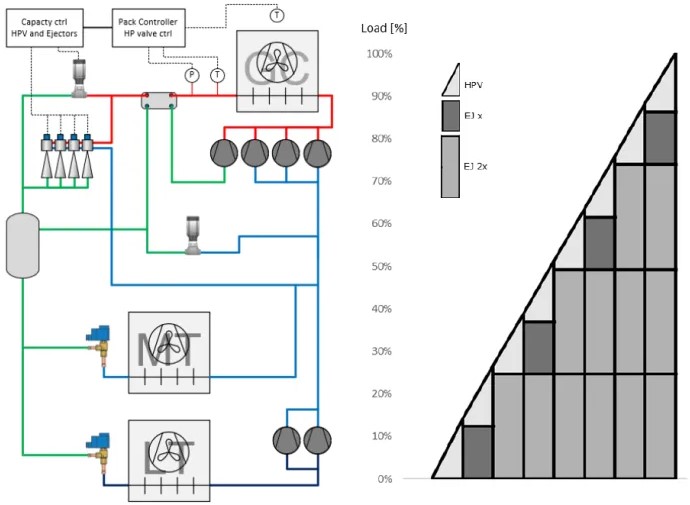Danfoss introduces a new algorithm for enhanced control of ejectors and high-pressure valves in a CO2 industrial system
May 24, 2023
Danish component manufacturer Danfoss has unveiled an algorithm to optimize the control and distribution of refrigerant flows between ejectors and high-pressure valves in large industrial transcritical CO2 (R744) systems.
Ekaterini Kriezi, Global Application Expert for Danfoss, described the algorithm at the 10th International Institute of Refrigeration (IIR) conference held in Ohrid, North Macedonia, April 27–29.
“The algorithm, introduced to control the capacity and instabilities, aims to provide improved system efficiency, reduce energy consumption and enhance overall performance in applications exceeding 1MW [284.34TR],” Kriezi stated.
“Our simulation model demonstrates the immense potential of our algorithm-controlled ejectors and high-pressure valves,” said Kriezi. “We have effectively addressed the efficiency limitations at varying loads, achieving a COP that rivals parallel compressor systems, while maintaining superior performance in comparison to ejector-only systems.”
Traditionally, fixed-capacity ejectors have been used for various applications in CO2 transcritical systems; however, controlling the system capacity in off-design conditions has been a challenge. To address this issue, Danfoss developed a multi-ejector solution, which uses an array of different-sized ejectors to control the system in a stepwise manner.
While effective for applications with a design capacity below 300kW (85.3TR), this multi-ejector approach becomes impractical for large systems due to the requirement of a significant number of ejectors. To solve this issue, the new algorithm combines the utilization of a high-pressure valve or a variable-capacity ejector with an array of large-capacity ejectors.
Test in supermarket lab
Kriezi highlighted key findings from a simulation and experimental setup. The experimental setup was done in a supermarket lab at the Danfoss Application design center in Nordberg, Denmark, to investigate the algorithm.
The COP of the system was calculated using the simulation model and compared with the COP of the system with only ejectors as the throttling device. The COP at loads up to 15% is equivalent to the COP of a parallel compression CO2 system. The reduction of the COP for low loads is about 6% when the small ejectors and valves are in operation. For loads exceeding 60%, the COP reduction associated with an algorithm-controlled system was limited to a mere 2%.
The new algorithm’s purpose is to determine a smooth transition for the load and avoid system instabilities by controlling the high-pressure valve and the ejectors.
 Algorithm setup to control system
Algorithm setup to control system
Danfoss’s algorithm setup to control a high-capacity system
The algorithm gets the high-pressure control signal from the system’s main controller as an input corresponding to desired mass flow rates. This is designed to maintain the high pressure (gas cooler pressure) according to the system setting.
When the combined mass flow rate through the valve and ejectors exceeds the desired value, the system’s high-side pressure will decrease. On the other hand, if the mass flow rate is lower, the pressure in the gas cooler will rise. These variations can lead to operational instabilities, causing energy inefficiencies and potential damage to components.
In the new algorithm, the coordination and load distribution among the high-pressure valves (one high pressure valve, 1 small ejector, and 3 large ejectors) are implemented.


